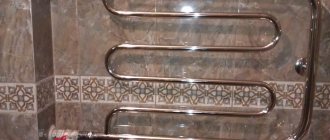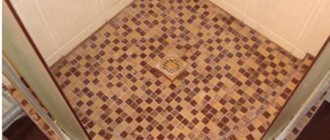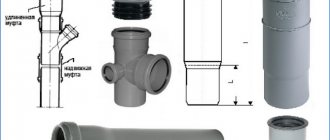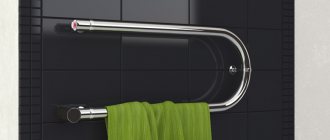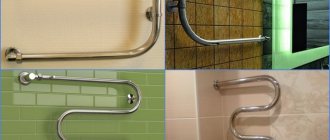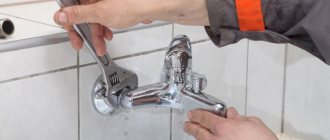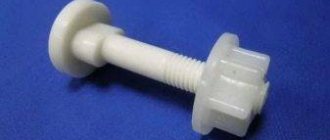The counters of markets and hardware stores fascinate with the shine of new heated towel rails. Any house owner cannot resist the opportunity to make functional and aesthetic changes to his home. After purchasing the selected device, you should find out how to install and connect it.
You will learn everything about how to replace a heated towel rail in a bathroom in accordance with regulatory requirements by reading the article we presented. We have described the technological steps in detail and listed the subtleties of the process. To help independent craftsmen, connection diagrams for heated towel rails are attached.
Tools for work
In order to do the work of replacing the dryer yourself, you will need the following tools:
- angle grinder (grinder);
- thread cutting tool (die);
- perforator;
- building level;
- adjustable wrench.
Fastenings and connecting elements are most often included in the heated towel rail kit. Depending on the type of finishing, the design and size of the device, the diagram and method of its connection, additional tools and materials may be required. Therefore, it is better to think through a technical solution to these problems in advance.
When connecting an electric heated towel rail, you will need tools for laying the cable and socket - a screwdriver, staples, a multimeter.
Threading and pipe fastening
To connect to the riser, the remaining parts of the pipe must be threaded. It is most convenient to use a lever mounted on a ratchet with a long handle. You must first apply any lubricant to the pipe. It is important to ensure that the leech goes in smoothly.
The thread is cut as follows: half a turn forward – a quarter turn back. There is no need to rush during this operation.
Which pipes are best to use?
- To supply water to the heated towel rail, it is more convenient to use reinforced plastic pipes. It is not necessary to buy a soldering iron for welding; you can borrow it from friends or rent it
- You can use steel pipes, but connecting them will require quite complex welding work. They weigh a lot and are susceptible to corrosion.
- Copper pipes do not rust, but they will have to be connected by soldering, and they cost a lot.
USEFUL INFORMATION: Wood-look bathroom: design elements and wood finishes (20 photos)
Fittings are screwed onto the resulting threads on the pipes. For compaction, use flax tow and Unipak paste. There are recommendations to use waterproof sealants, but then the connection will be permanent.
Installation of polypropylene pipes is simple. To connect them, various fittings, angles and couplings are used. The welding soldering iron comes with instructions that describe in detail the entire process of pipe soldering. There are several important points:
- When soldering plastic pipes, it is strictly forbidden to rotate them.
- It is not recommended to use tow to seal polypropylene pipes.
- The supply line must be installed in such a way as to provide the heated towel rail with a distance of at least 35 mm from the wall. With a coil diameter exceeding 23 mm, the offset increases to 50 mm.
- Tightening plastic fittings should be done with special strap wrenches; using gas ones can lead to damage to the connecting element.
- It is imperative to install a Mayevsky valve into the system to bleed air.
- Shut-off valves on pipes must be reliable.
- During installation, it is better to use “American fittings” (fittings that allow you to connect system elements by tightening a union nut), so that later you can easily disassemble the entire system if necessary.
Step-by-step instruction
First you need to clarify the type of device being replaced and its connection type. Depending on the method of connection, dryers can be water or electric, and by design they are panel devices in the form of a “coil” or “ladder”. When replacing a heated towel rail in the bathroom with your own hands, it is better to replace it with a similar or similar model.
Water devices are connected to hot water pipes or to the heating system. The first method is preferable because the coil will be warm whenever there is hot water. In the second case, it will heat up only during the heating season.
The advantage of an electric heated towel rail is its independence from power systems. It works all year round and can be installed anywhere.
Preparing to replace a heated towel rail
From among the devices offered by the retail chain, we will purchase a dryer and mounting elements, taking into account the installation method, the diameter of the connected pipes and the assigned tasks. We will inspect the structure being replaced in advance and find out how to connect it to communications. Let's measure the distance between the water inlet and outlet. It is best if the new heated towel rail has the same gap as the previous one. Otherwise, you will have to change the design of the dryer and buy additional fittings.
The dryer can be connected in parallel or in series with respect to the riser pipes. If it breaks the flow of water, then to replace it you need to call a housing department plumber and temporarily disconnect the riser from the hot water system. Only a representative of the operating organization has the right to do this.
Installing a heated towel rail parallel to the supply pipe with a jumper device does not interfere with the circulation of water in the riser. In this case, it is enough to disconnect the dryer from the hot water system by turning off the taps and directing the water flow into the riser.
The finishing of the connection point is important. It can occur in the groove (a more complex option), or outside. To do this, you may need to purchase the necessary materials, for example, drywall or tiles to mask the joint.
Diameter discrepancies are easily resolved. Adapters are used to connect such pipes.
Thus, to solve the problem of replacing a heated towel rail in the bathroom with your own hands, you must first do the following:
- purchase a heated towel rail of the desired design;
- collect the necessary tools;
- think over and draw a diagram of installation and finishing;
- prepare materials and components.
Dismantling the old installation
If the old heated towel rail is installed using a threaded connection, it can be easily removed by unscrewing the nuts and screws. When the old device is connected by welding or it is no longer possible to unscrew the thread, you will have to cut off the heated towel rail with a grinder. To do this, we will shut off the water in the riser by calling a plumber from the housing maintenance organization.
When cutting the thread, you need to leave bends so that a new device can be connected to them. The incision site must be positioned strictly vertically. To do this we use a building level. On the remaining ends of the pipes we will make small chamfers at an angle of 45°. This will make threading easier.
We will also cut off the old heated towel rail mounts with a grinder.
Connecting new equipment
Using a die (cutter), we cut the threads on the saved bends, having previously lubricated them with machine oil. This should be done carefully, gradually turning the lever half a turn, then a quarter turn back, etc. We apply markings in the place where the heated towel rail mounts are installed, placing it against the wall. Using a hammer drill, we drill into the wall at the designated points. To connect the elements of the system, an “American” is used, i.e. fitting with union nut. Compaction is done with flax strands or Unipak paste. Tighten all nuts with a wrench.
Using Bypass
Installing a jumper allows you to turn off the device in offline mode. When repairs are made due to damage or malfunction of the towel dryer, coolant still circulates in the riser through a spare channel - the bypass. Water distribution is done using tees.
A ball valve is installed between the jumper and the dryer. At the second output end a Mayevsky valve is installed to bleed air.
How to check connection quality
After installing the device, water is gradually supplied to it to check the tightness of the connections. This must be done slowly to avoid water hammer.
What is the procedure for replacing an old heated towel rail through the housing office?
How to choose a contractor?
If you decide to entrust all the work to professionals, then you need to seriously think about their choice - you should not trust the first one you come across. Here, naturally, the cost of services and the time of their provision play a big role.
However, we must not forget about the reputation of the company. Moreover, they must provide documentation that gives them the legal right to carry out such work. The main documents are the SRO certificate of approval and the contract. It is the SRO certificate that is important, since the license has been canceled since 01/01/2010.
Of course, replacing a heated towel rail and the price for performing the work in this case will be higher than that of ordinary performers. At the same time you receive the following benefits :
- qualified order execution;
- high-quality components;
- contractor's liability;
- warranty obligations.
All this can be lost if the replacement is made by a “left” plumber. It’s good when negative consequences can be avoided, for example, a simple leak, after which you will have to redo not only all the work, but also carry out repairs for flooded neighbors. Therefore, it is better to immediately contact a company with relevant experience and documentation.
Let's go to the housing office
So, the choice of the master has been made, but this is only the beginning of the process. Now there is a not entirely simple procedure for disconnecting the riser to which the towel drying device is connected. Some companies, when replacing an old heated towel rail through the housing office , take on this hassle, although they require a certain fee for this.
However, not everyone is able to pay for this service, so we will consider the process in more detail. The procedure is as follows:
- contact the housing department with an application containing a request for permission to change the old towel drying device;
- upon receipt of permission, contact the dispatcher and agree on the time for the work to be completed;
- install the unit and check its operation;
- invite a representative of the housing department to check the compliance of the work performed with the permit.
Housing department employees do not have the right to refuse to disconnect if the contractor’s company has all the permits. The reasons for refusals are always related to attempts to impose their services, and at inflated rates. In case of refusal, the reason must be indicated, and if the illegality of the actions of the office manager is discovered, a lawsuit should be filed.
Installation of electric heated towel rails
The installation is carried out similarly to the wiring arrangement for any electrical equipment in the house. A groove is made for the three-core cable (groove). A wire is laid in it with fastening strips or buckles. It connects to a box with clamps. The blue conductor is neutral, the yellow-green conductor is grounding, the bright conductor is phase. The heated towel rail is grounded and connected to an RCD (residual current device) or differential circuit breaker. Install the socket. The cable is laid in corrugation.
Dismantling
Serial Soviet coils are connected to the main line by means of a threaded coupling or by welding. The first method allows for disassembly: loosen, screw the locknut all the way, and twist the coupling with a gas wrench.
Paint on the threads that interferes with the operation is removed with a metal brush (brushing) or burned with a torch. The thermal method is suitable for major renovations of a bathroom, otherwise the lining is protected with an asbestos sheet.
The welded elbow is cut off with a grinder. Do the same with brackets attached to pipes. To avoid damaging the finish with flying abrasives, place plywood or cardboard between the knee and the wall. The latter is convenient to attach to the tile with tape.
Replacing an unusable heated towel rail without updating the bathroom line is irrational. The chrome ladder will serve properly, and fistulas will appear on the steel riser and inlets, so think about plastic.
Cutting the steel route near the ceiling and floor is a bad idea: pipes tend to leak in the ceiling. It is better to agree with your neighbors to jointly replace rusting pipes with fiberglass-reinforced polypropylene pipes. If the answer is negative, leave nozzles protruding 100 mm above the plate so that the thread-cutting tool can fit. Sometimes you have to dismantle the tiles to free up space.
If the riser is not touched, as a rule, they try to choose a towel that is identical in its center-to-center dimensions. For bent modifications of other dimensions, the insert will need to be moved. Sometimes they redo the plastic wiring, then they make do with plastic scissors. When cutting off the existing one, take into account the need to install taps and lintels.
Features of choice
If you don’t know which heated towel rail is best to choose, you should pay attention to the technical characteristics of the models, which must correspond to the pressure level during pressure testing and operation of the system. If we take into account the requirements of GOSTs and building codes that regulate the installation of water supply and heating systems, water-folding sanitary fittings should be used at a pressure of up to 6 atmospheres.
Theoretically, the pressure should not exceed 4 atmospheres, but in practice this value can vary from 2.5 to 7.5 atmospheres. The final value will depend on the location of the building, the number of floors and the condition of utilities.
Before purchasing a water coil, you should find out what pressure is maintained in the house, taking into account the possibility of water hammer. For a country house where the heating and water supply systems are autonomous, the pressure usually does not exceed 3 atmospheres, so choosing a device will not be so difficult.
Additional information for self-installers
Sometimes inexperienced craftsmen make mistakes and these omissions lead to the fact that the heated towel rail remains cold despite the proper operation of the hot water supply system, and the whole problem is an incorrect connection.
To prevent this from happening, you need to pay attention to the correct and accurate connection diagrams, especially for electrical and combined devices for drying towels.
The water supply to water and combined towel dryers can be:
- lateral (both pipes are directed either to the right or to the left)
- vertical (the upper pipe is directed upwards, the lower one is directed downwards)
- lower (both pipes point down).
In houses with central heating, all connections in the bathroom are first made under a water heated towel rail. In order to install a ladder dryer, you will need to carry out work to move the pipes.
And also, the water pipe must be equipped in the upper part with an air valve (Mayevsky valve), which is needed to remove air in the pipe. If this is neglected, an air lock may occur and the heated towel rail will not be able to operate at its full available capacity.
Types of towel rails
A heated towel rail is installed in almost every bathroom. Its main purpose is to ensure drying of laundry. At the same time, the device can perform the function of both primary and additional heating of the room.
Classification of heated towel rails is carried out according to the type of coolant:
- Water devices. There are two options for connecting such a dryer. The first is that this device is connected directly to the heating circuit, and it is heated due to the circulation of the coolant liquid in the home heating system. The second is the installation of a heated towel rail to the hot water supply.
- Electric towel dryers. The device does not require connection to the heating system. To operate the heated towel rail, you must have an electrical outlet in the bathroom.
- Combined type devices. This towel dryer can operate simultaneously from electricity and water flow. The product is connected to the heating circuit, and a heating element is connected to it.
Electric and combined dryers can be used at any time of the year. Devices connected to the heating system operate only in the cold season. When the heating is turned off, the water drying process stops. The exception is when the device is connected to a year-round hot water supply.
Heated towel rails come in a variety of sizes and configurations. Simple models have a zigzag or ladder shape. The simpler the dryer design, the easier its installation.
Using Bypass
In order for the system to function more efficiently, it provides for the installation of a bypass. It is a spare channel to which you can connect any equipment involved in heating. Its task is to ensure the functioning of the system when emergency situations occur in the connected components.
Usually, novice craftsmen do not think about the fact that leaks may occur. They fix the coils to the main pipes without installing shut-off valves. This approach during operation can cause a violation of the tightness of the connections and flooding of the room. This can have negative consequences if the room is located in a high-rise building with central heating.
When an emergency occurs, it may take a long time for the water supply to stop. Blocking and restoration work can leave part of the house without heat for an extended period of time. The bypass design is quite effective and simple, it allows you to gain confidence in the situation and not worry about the health of the equipment.
To carry out the work, you will need to create a kind of riser for the heated towel rail by installing tees at the ends of the pipes. Two directional outlets should be connected to a pipe. Side outlets are necessary for installing shut-off elements; pipes will be connected to them, which go to the heated towel rail.
When a structure is assembled from flexible ready-made connections, during its installation one should not forget about the use of sealing materials. When installing a plastic pipeline, you need to use a soldering iron. The master will need the help of one more person. When rigid connections are used for connection, you need to ensure compliance with the horizontal and vertical levels. Otherwise, the installed coil will not be able to be fixed evenly. Its incorrect position can ruin the entire impression of the repair.
Selection by material of manufacture
How to properly remove a heated towel rail is not the only thing you should familiarize yourself with before purchasing a new model. It is also important to understand what material is at the heart of the future device, as well as which option is a priority. In the production of water heated towel rails, the following are usually used:
- black steel;
- stainless steel;
- non-ferrous metals.
Among the latter, aluminum, copper and brass should be highlighted. On sale you can find polished, chrome-plated and painted coils. If the homeowner decides to change the heating device, he should be interested in which material is better to choose. For example, appliances made of steel, which are an alloy of various elements with iron and carbon, are reliable and durable. Structurally, they are almost no different from their conventional stainless steel counterparts.
Steel radiators conduct heat quite efficiently and are coated on the outside with a layer that protects against corrosion. Iron coils are considered the most budget option. They are ideal for those who want to save money. These heated towel rails, however, have their drawbacks. One of them is expressed in a short service life.
If you are looking at stainless steel heated towel rails, you should know that these units are reliable and ready to last for a long time. The main advantage of such coils is that stainless steel can withstand high pressure, in addition, it is resistant to corrosion.
Copper and brass products are the golden mean between other devices. The material has an attractive golden color. It does not corrode, but costs a little more than its stainless steel counterparts. The maximum permissible pressure that such a device can withstand is 6 bar. This feature indicates that the device is well suited for installation in private homes, where the water pressure usually does not exceed 3 atmospheres.
Inappropriate connection schemes
The established rules and regulations do not allow:
- install any fittings on the bypass;
- Unauthorizedly carry the drying device over a long distance.
- change the diameter of pipes during installation;
- carry out independent transfer of the riser.
To install a heated towel rail yourself, you need a thoughtful approach, attentiveness and the availability of the necessary tools.
Similar articles
How to change bathroom pipes with your own hands
Causes of leakage in shower cabin elements
How to fix a leaking pipe in the bathroom
Why doesn't the heated towel rail in the bathroom heat up?
How to install or replace a towel dryer?
As already reported, such work is completely doable with your own hands, only in this case all responsibility for the quality of installation will rest with you. Connecting the device in apartments is carried out using two methods :
- to a central or autonomous heating system (CO);
- to the hot water supply system (DHW).
At the height of the heating season, connecting to a central heating system is extremely difficult, one might even say impossible.
The connection process consists of the following points:
- dismantling a faulty device;
- welding or soldering of pipes;
- bypass installation;
- installation of a new device.
But this is not all that the apartment owner will have to face.
Preparation
If you need to move the device away from the riser, then before removing the heated towel rail, you will need to obtain written permission from the management company. The thing is that the further the device is located from the general water supply flow, the worse it will function, reducing the water pressure throughout the house.
It is prohibited to carry out such work independently without obtaining permission. It is most convenient to replace it in the summer, when the hot water supply is turned off. An excellent period will also be the time when preventive work is carried out.
Decorating the installed device
The pipes to the hot water supply can be decorated. You can use different options for this. One of which is the installation of a plasterboard or plastic box where the water supply and the riser itself will be hidden. The installation of the box is carried out taking into account the following features:
- small channels are made at the junction of the box and the floor, which will help to detect a possible leak in time;
- It is better to equip the box with a door, which will be located opposite the locking system.
the presence of a door will allow access to the taps. This is necessary in order to carry out repair work on time. Pipes can also be walled up in the wall; to do this, you need to make indentations using a hammer drill. The grooves are subsequently filled with gypsum mortar, and tiles are laid on top.
Connection Quality Test
It is necessary to check the quality of the connection. There should be no leakage at the connections. Connecting a heated towel rail to the general system is carried out in several ways. The most effective is the side or diagonal option. The system works ideally with different directions of flow in the riser and does not depend on the speed of water flow.
With a lower connection, the riser outlet is made below the point of connection to the dryer; with the upper version, the riser outlet should be above the connection point with the heated towel rail. Also, for normal water circulation in the pipes, the slope of the supply system must be observed. The level of difference ranges from 3 to 30 mm. The bottom connection eliminates any narrowing.
If problems are noticed when testing the connection quality, you need to check for the following defects:
- the dryer is located below the lower outlet, the water cools and stagnates in the lower part of the structure, it does not flow into the common riser due to the pressure of hot water, the natural process of water movement is disrupted;
- the upper pipe is bent in a loop, air collects in it, which disrupts circulation; to avoid this, you need to install a Mayevsky air release device;
- Air accumulates in the loop of the upper pipe, water collects in the sump due to the loop in the lower pipe.
With a diagonal connection, more problems may arise. In the process of work, it is necessary to more carefully think through and work out the existing design.
In order for water to circulate well, the following design features should be adopted:
- the lower insertion point is located below the pipe;
- the structure should not have unnecessary bends so that water does not accumulate;
- the diameter of the liner must exceed 25;
- the permissible range of distance from the riser is no more than 4.5 meters;
- with a lower connection, a narrowed bypass is required;
- When connecting hidden, thermal insulation is required.
All pipelines must be located below the tapping point. If the recommendations are followed, water will circulate through the pipes efficiently, without stagnation.
Where to go to replace the structure
Diagram of the heated towel rail
If you don’t want to deal with replacing the heated towel rail yourself, then you have several options for further action. The easiest way is to contact the housing office and order installation of the device there. However, not everyone is ready to entrust their home to employees of a management company.
The second option is to order installation in the same place where you will buy the heated towel rail. Large companies also provide such services. Moreover, wanting to attract customers, they often offer favorable conditions for their clients.
If you turn to the housing office for help, you will have to pay from 1.5 to 2 thousand rubles for the work. But this is only if alteration of the hot water supply riser is not required. Otherwise, the price for the work will increase many times and range from 5 to 15 thousand rubles. Bypass installation is calculated separately: from 4 to 8 thousand rubles.
Don't chase too low a price. As a rule, those who underestimate the price are those who do not hope to attract clients with quality, experience and recommendations. But an inflated price does not guarantee high quality.
Selection by manufacturer
When considering the most popular companies that produce sanitary equipment, you should pay attention to the Arbonia brand. This is a Swedish-German concern; it began its activities at the end of the nineteenth century, when a small workshop for the production of steel pipes was opened at the blacksmiths base.
Today the company produces heated towel rails that are sophisticated in appearance and quality. The technical characteristics of the products are suitable for installation in bathrooms, since tubular radiators are provided for other rooms. Another distinctive feature of the brand is the production of not only water, but also electric models of coils. On sale you can also find combined models, the analogues of which cannot be found among competitors.
The Italian company Margaroli has been producing such equipment for 60 years. During this time, the brand has achieved high quality products, and products are tested in several stages. They are offered in a wide variety of design solutions, are ergonomic and multifunctional. Heated towel rails from this company can fit into any interior. The brand’s modern solution is the production of stationary and portable heated towel rails.
Zehnder is a German company that ranks first in the production of functional and ultra-modern heated towel rails. The company achieved this position through the production of high-quality products that are supplied to the market in 200 different shapes and sizes.
If you want to purchase the best domestically produced water heated towel rail, you should consider the Terminus company, which specializes in the production of heating equipment. The strength of the brand is that in the offered assortment you can find products made using different technologies. For example, heated towel rails may not have welded seams and be made from high-quality pipes.
This company has a variety of stainless steel heated towel rails that are offered in different designs. These can be U-shaped models, in the form of a shelf or ladder. The dimensions can be very different, for example 600 x 400 mm or 496 x 532 mm.
You can choose a stainless steel heated towel rail to suit different budgets. The most reasonable price is 875 rubles, but more expensive models can also be found on sale, for example, costing 8,600 rubles. In the latter case, we are talking about a coil in the form of a ladder with a shelf.
